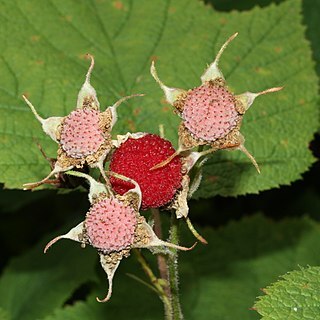Unarmed shrub 1–2 m, the younger parts, petioles, and pedicels usually stipitate-glandular; lvs rotund to reniform in outline, 1–2 dm wide, shallowly ca 5-lobed, the lobes serrate, acute; fls few, white, in a long-pedunculate cymose cluster; sep with orange-yellow very short gland-tipped hairs; pet elliptic-ovate, 1.5–2 cm; fr juicy, edible, red, 1.5 cm thick, pubescent, falling as a unit from the persistent receptacle; 2n=14. Open woods and thickets; Bruce Peninsula, Ont., to n. Mich. and n. Minn.; S.D.; widespread in the western cordillera. May–July. (Rubacer p.)
A shrub. It grows 4.5 m high and spreads 3 m wide. It loses its leaves during the year. The stems are upright. The bark peels off. There are no prickles. The new growth is furry. The leaves mostly have 5 lobes. There are uneven teeth along the edge. The flowers are white. The fruit are red.

